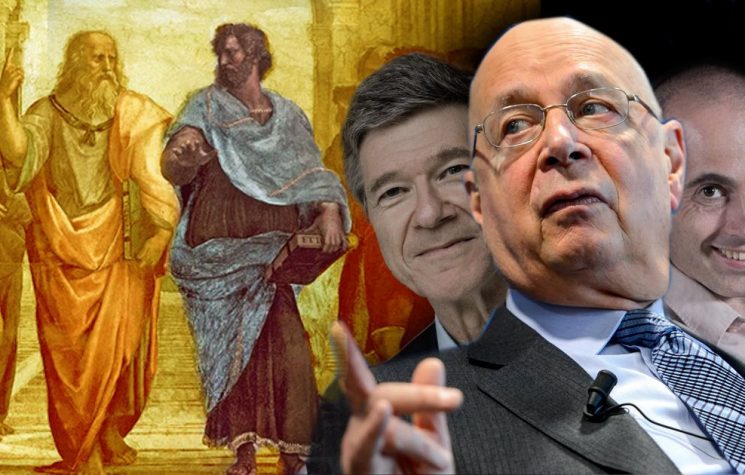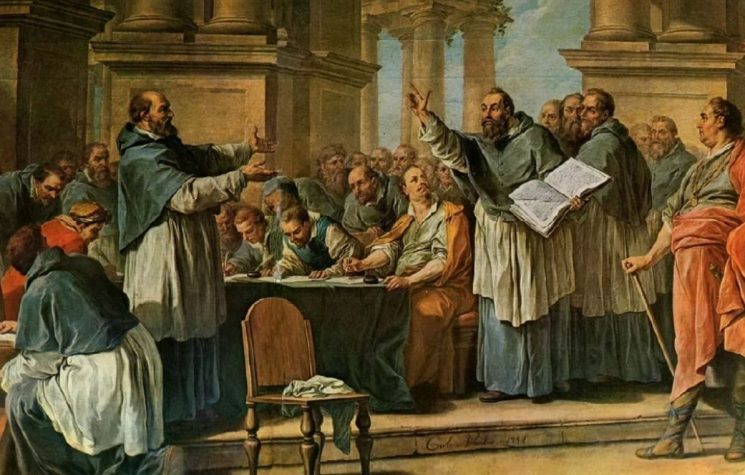The idea that anti-republican John Locke inspired the founding of the USA has been a strategic myth which has kept generations of Americans from understanding their own moral roots.
This is the 2nd of a five part series. Part one ‘On the Cult of Aristotle’ which introduces the two opposing currents of ‘western thought’ leading up to Kepler’s “banning Aristotle from Christendom” can be accessed here.
In his 1689 Essay on Human Understanding, the British empiricist John Locke (1632-1704) revived Aristotle’s theory of the blank slate and in so doing defended his notion that slavery was an immutable part of the universe. Locke’s thesis that slaves could be legally considered mere “property” was enshrined in his drafting of the constitution for Carolina and also justified his own vast shares in the British Royal Africa Company that extracted millions of black slaves from Africa to the British American and Caribbean colonies during his lifetime. In his 1689 treatise, Locke wrote:
“The souls of the newly born are empty tablets, only afterwards filled in by observation and reasoning… When does a man begin to have any Ideas? I think the true Answer is, When he first has any Sensation. For since there appear not to be any Ideas in the Mind, before the Senses have conveyed any in… T’is about these Impressions made on our Senses by outward Objects, that the Mind seems first to employ itself in such Operations which we call, Perception, Remembering, Consideration, Reasoning, etc. In time, the Mind comes to reflect on its own Operations, about the Ideas got by the Senses, and thereby stores itself with a new set of Ideas, which I call Ideas of Reflection. The simple Ideas, the Materials of all our Knowledge, are suggested and furnished to the Mind only by those two Ways above-mentioned…”
In drafting the constitution for the Carolinas, Locke outlined a system of hereditary power, and codified slaves as “leet men”:
“XIX: Any lord of a manor may alienate, sell, or dispose to any other person and his heirs forever, his manor, all entirely together, with all the privileges and leet-men there unto belonging….
“XXII: In every signory, barony and manor, all the leet-men shall be under the jurisdiction of the respective lords of the said signory, barony, or manor, without appeal from him. Nor shall any leet-man, or leet-woman, have liberty to go off from the land of their particular lord, and live anywhere else, without license from their said lord, under hand and seal.
“XXIII: All the children of leet-men shall be leet-men, and so to all generations.”“CX: Every freeman of Carolina shall have absolute power and authority over his negro slaves, of what opinion or religion soever.”
The idea that anti-republican John Locke inspired the founding of the USA has been a strategic myth which has kept generations of Americans from understanding their own moral roots.
Leibniz Steps Into the Fight
For the sake of counterpoint, a leading follower of Kepler during Locke’s lifetime was the great scientist/statesman Gottfried Leibniz (1646-1716) who took aim at the poisonous doctrine revived by Locke’s works and dismantled them in the form of a long Platonic dialogue called The New Essay on Human Understanding finished in 1704 yet only published 50 years after Leibniz’s death. Leibniz was particularly well placed to do battle with Locke’s Aristotelian revival due to the fact that unlike Locke, Leibniz had made genuine acts of revolutionary discovery culminating with his most famous invention of the infinitesimal calculus (a language to chart non-linear physical curves found outside of the abstraction of Euclidean space).

Leibniz’s logic of physical reality diverged from his rivals due to his commitment to the essential transcendental nature of the constancy of Euclidean abstract forms when pressed upon the discoverable curvature of physical reality. While there is an obvious connection between the two domains of mind and matter, there are also extremely important divergences which can be recognized as soon as anyone wishes to create a circle or square, cube, ellipse or any other shape within the material domain. As perfect as such a shape may appear, and no matter what refined technology one chooses to use to carry out the task, there is no singular instance that a more perfect straight line, or more perfect square, ellipse or circle could not be produced.
Leibniz and his collaborators like Jean Bernoulli, Christian Huygens and Pierre de Fermat explored these physical curvatures by observing the pathways traced by planets, comets, and light moving through different media. He also spent much time analyzing the ironical relationship between time and space expressed by the rolling of balls down various curves taken from sections of circles, ellipses, straight edges or cycloids. Despite the fact that shortest distances between points A and B may appear intuitively to be the quickest pathways for a ball to take, physical reality demonstrates that this is not so.
Out of these studies, Leibniz recognized that geometries in reality were best described as “least-action pathways”… that is, nature when left free to express itself moved according to a fundamental economy that “chose” pathways of greatest action with least effort. Another term for this economy of nature was known as the “Minimum Maximum Principle”.
When asking why planets moved on the pathways they did, rather than some other configuration, the answer for Kepler or Leibniz would not be “because they move in ellipses” or “because their velocity and masses demanded it”, but rather that they moved in harmonic least action pathways (more to be said on this below).
In his refutation of Locke, Leibniz writes: “Our differences are on subjects of some importance…The question is to know whether the soul in itself is entirely empty, like the tablet on which nothing has yet been written (tabula rasa) according to Aristotle and the author of the Essay [Locke], and whether all that is traced thereon comes solely from the senses and from experience; or whether the soul contains originally the principles of several notions and doctrines which external objects merely awaken on occasions, as I believe, with Plato, and even with the schoolmen, and with all those who take with this meaning the passage of St. Paul (Romans 2, 15) where he remarks that the law of God is written in the heart.”
Leibniz was consistent in this view and had already been loudly making this point 20 years earlier in his Discourses on Metaphysics (1686), saying:
“Aristotle preferred to compare our souls to as-yet blank tablets that could be written on, and he held that there is nothing in our understanding that doesn’t come from the senses. This squares better with everyday notions, as Aristotle usually does and unlike Plato, who goes deeper.”
A World on Leibniz as Cultural Warrior
It is here worth noting that Leibniz was no ivory tower philosopher but was engaged in front line efforts to organize leaders to become philosopher kings while also creating cultural institutions to elevate the standards of the culture towards excellence. Some examples of leading figures whom Leibniz found himself advising in grand strategy are: Czar Peter the Great who made Leibniz Russian Privy Councillor and assigned him the task of reforming the entire Russian legal system, Emperor Charles VI who made Leibniz Privy Councillor to the Holy Roman Empire, The Duke Anton Ulrich who made him chief diplomat and Empress Sophia of Hanover who was a devoted student of Leibniz and nearly became Queen of England which would have certainly made Leibniz Prime Minster during a period when England was being transformed into a new central command by the Dutch-Venetian oligarchy.
In regards to institutions of science which Leibniz directly founded, we find the Academy of Science of Berlin, Vienna and even St. Petersburg.
Leibniz worked with co-thinkers in China and was the first western thinker to popularize Confucian thought into Europe via his journal Novissima Sinica (News from China). Being a devout Platonic Christian, Leibniz was quick to identify the same fundamental concepts of Agapic love, pre-existent harmony, principle and natural law expressed within the Chinese Confucian worldview and worked to teach his fellow Europeans to think on similar terms as the basis for a civilizational renewal based on East-west cooperation.
Leibniz also improved Pascal’s calculating machines with new designs that involved performing division, multiplication and finding roots. This work was inextricably linked to Leibniz’s studies of Prime Numbers (the most anomalous and perhaps powerful of all species of number) which led him to invent Matrices. These inventions set the foundation for Carl Gauss’s later revolutionary developments in non-Euclidean geometries and Riemann’s work on hypergeometries.
While struggling with the challenge of creating a geometrical language that would be compatible with mapping the universe in the macro and micro cosmos, Bernard Riemann had made it know that the key to his success was located in his studies of Leibniz’s refutation of Locke. Writing to a colleague, Riemann said:
“The most important thing that I read in Leibniz was his devastating critique of the British empiricle philosophy of John Locke… What I really began to understand here for the first time is how the human mind works, and what I have to learn and understand in order to do the kind of work I’ve been trying to do effectively, as a mathematician and as a physicist over the past several years.” (1)
Taking inspiration from the notation in the I Ching, Leibniz invented binary language which served as the basis for modern computers.
A brief full overview of Leibniz’s accomplishments in science, economics, cultural warfare and geopolitics is outlined in Kirsch’s 2013 study Leibniz vs Venice.
Leibniz Battles Newton’s Irrational God
Perhaps more important than his battle with John Locke was Leibniz’s battle with another British Empiricist named Sir Isaac Newton (1642-1727). The fact that both Locke and Newton had worked closely together at the Bank of England is probably not a coincidence.
After serving his young niece as a sexual plaything to Chancellor of the Exchequer Charles Montagu (aka: Lord Halifax) (2), Newton was rewarded the position of Warden of the Mint of the Bank of England in 1695 and Master of the Mint from 1699-1727 where he oversaw the mass execution of counterfeiters and economic warfare that the newly emerging British Empire had begun to wage on the nations of the world. At this same time, Newton was also made President of the British Royal Society where he moved its headquarters into the square mile City of London which not coincidentally was, and remains the nerve center for global imperial warfare. It was also at this time that Newton led a team of British academicians to conclude that Leibniz had plagiarized the calculus from Newton despite the fact that Leibniz had published his discoveries of said calculus years before Newton claimed to have invented his “fluxion” variant.
Despite the fact that Newton never explained HOW he discovered his calculus and despite the fact that his notation was never used by practical astronomers or physicists due to its being useless, Newton is still taught as either the primary or at least “co-discoverer” of the calculus to students 300 years later.

Gottfried Leibniz (left) and Sir Isaac Newton (right)
Since Newton was rarely permitted to speak on his own behalf in public, handlers like Samuel Clarke (1675-1729) and William Whiston (1667-1752) often stood in as his spokesmen in debates and disputes.
In the Leibniz-Clarke correspondence conducted in 1716, Clarke explained that it wasn’t necessary to explain how Newton discovered the calculus since it’s existence was implicit in the proofs laid out in his Principia Mathematica (1687).
If Newton had not discovered the calculus, then he could not have come up with various many mathematical proofs published in the Principia. Thus, had he not discovered the calculus, then it must be presumed that the Principia was simply a composite of plagiarized discoveries made by others… but who would have the gall to accuse the great Newton of such a thing?
For those who persisted in asking where the evidence of Newton’s plethora of discoveries was found, the story that Newton’s dog Diamond burned down his laboratory was concocted as an explanation which persists to this day. According to legend, Newton was recorded as having said: “O Diamond, Diamond, thou little knowest the mischief thou hast done.”

A 19th century etching portraying the sad day Newton’s dog burned all the evidence of his supposed discoveries
For those genuine scientists like Royal Society astronomers John Flamsteed or Stephen Gray who did not accept such bilge but wanted a real answer, their lives were systematically destroyed by campaigns led by Newton himself (as told in Newton’s Tyranny: The Suppressed Scientific Discoveries of Stephen Gray and John Flamsteed by David H. Clark, Stephen P. H. Clark)
Towards the last year of Leibniz’s life, the great scientist took aim at the most destructive outcome of the Newtonian mechanical system which presumed a universe of slowly winding down like a clock. Newton’s mechanistic system would be the first expression of a theory that later came to be dubbed “entropy” in the late 19th century with which we will soon deal in greater depth below.
In short, the Principia presupposed a dying universe and irrational or impotent Creator devoid of any wisdom. The Principia also presumed objects floating within empty space moved about by forces of attraction acting in absolute time without any need for causal metaphysics (aka reason for things being arranged the way they are rather than otherwise). (3)
The idea of a dying universe implicit in the Newtonian model additionally carried certain implications about the Creator of said universe. For if God, who is presumed to be all wise and all good cause of all, created a machine that required its artificer to periodically re-wind it every so often after it decayed to heat death, then that would imply an incredible embarrassing design flaw. Must not a perfectly wise and perfectly creative God who made us in his image not also have had the foresight and power to create a universe that could self-perfect without winding down like a clock or automata?
Leibniz wrote: “I am not saying that the material world is a machine (a watch, say) that runs without God’s intervening, and I have pretty strongly insisted that the things he has created need his continual influence. But I do say that the material world is a watch that runs without needing to be mended by God, otherwise we would have to say that God changes his mind. In fact, God has foreseen everything, and for anything that might go wrong he has provided a remedy in advance. There is in his works a harmony, a pre-established beauty… This opinion does not exclude God’s providence or his government of the world; on the contrary it makes it perfect. A true divine providence requires perfect foresight.”
In the homogenous concept of empty space extending in three infinitely linear directions which Newton presumes as self evident, there is a rejection of the idea that any harmony and purpose of all parts to the whole universe needs exist.
It denies the idea that orbits of planets must be arranged around suns due to harmonic reasons as Kepler had discovered and rigorously demonstrated between 1609-1619. It denies that the nature of things are created as they are for a moral principle, which Leibniz maintained must be the case IF God were presumed to be both all good and all wise.

Within the course of the debate, the devil’s advocate Samuel Clarke asks Leibniz: Must not your universe of self-perfection deny mankind his free will? What account must be given for evil? Since evil exists, and since God created all that exists, must it not follow that God created evil? If all is foreseen in this “Best of all Possible Worlds”, then does that not also mean that human beings either have no free will, or that evil itself is necessary and thus wise and good?
Leibniz puts the paradox to Clarke in the following terms: “when two options are absolutely indifferent- meaning that there’s nothing to choose between them- there is no choice, and consequently no election or will, since choice must be based on some reason or principle… A simple act of will without any motive (a ‘mere act of will’) is a fiction. It is contrary to god’s perfection, chimerical and contractor, inconsistent with the definition of will.”
In short, the universe is the best of all possible universes not because of its static perfection as the Leibniz haters a la Voltaire maintain (4). Throughout his writings and his life’s political efforts at to establish philosopher kings across Europe and Russia, Leibniz clearly attests that it is best of all possible worlds, NOT because it is perfect, but rather BECAUSE it can always be made more perfect.
From Leibniz’s standpoint, it is humanity’s access to free will that causes evil to exist and it is because of our ability to participate in the process of universal progress that demonstrates that God is both loving, reasonable and good. This is at the heart of Leibniz’s Dynamics which hinges upon his profound concept of Vis Viva (a yearning for all matter to actualize its potential to the fullest extent possible also known as ‘living force’) as well as his Monadology.
It is only when we make the mistake of projecting our uncreative corrupt irrationalism onto God that evil finds its political expression in oligarchical systems of governance the way Newton’s God is more of an irrational tyrant than anything else.
This oligarchical delusion was portrayed brilliantly by Verdi’s treatment of Iago’s Credo in his operatic rendition of Shakespeare’s Othello.
Sadly, upon his death, Leibniz’s potent method was buried, and the myth of the proto-God Newton increasingly became legend throughout the courts of Europe. Generations of thinkers were trained to use Newton’s rules for reasoning if they wished to be considered “respectable” scientists and permitted entry into the halls of esteemed Scientific academies.
Removing Mind from the Universe
Among the most destructive rules of reasoning demanded by the Newtonian way” were 1) the mind’s enslavement to sense-perception (empiricism) and 2) the denial of hypothesis-formation.
Together, these two rules carved the creative soul out of the scientist, leaving only cold logic bounded by the five senses. The mind that believes it must adhere to such rules of thinking, are in truth merely handicapped in the same way that the victims locked into Plato’s cave could access nothing more than the shadows cast by puppet masters on the cave wall.
Such mind-slaves would be forever condemned to believe these shadows to be all the reality that exist, and only the intervention by one who learned to escape the cave and trained their mind’s eye to look upon the light of the sun (aka: Reality as it is) could qualify to become a true philosopher and POTENTIALLY return to help his/her fellow cave dwellers escape their shackles.
In the preface to his Principia, Newton explicitly states his objection to the use of hypothesizing saying: “I have not been able to discover the cause of those properties of gravity from phenomena, and I frame no hypotheses… and hypotheses, whether metaphysical or physical, whether of occult qualities or mechanical, have no place in experimental philosophy.”
Newtonian science took a major blow with Benjamin Franklin’s creative discovery into electric fire and its magnetic nature in 1752. The electric spread of new discoveries across continental science repeatedly proved the superiority of anti-Newtonian methods that embraced the more fruitful Keplerian/Leibnizian method of hypothesis formation, rigorous metaphysics and dialectic. Such discoveries were exemplified by the brilliant work of figures like Lavoisier, Carl F. Gauss, Abraham Kastner, Alexander Volta, and Alexander von Humboldt (to name but a few). But despite this creative potency, the Newtonian stranglehold was preserved through several novel adaptions which were created between 1776 and the present.
In the part three of this exploration into the 2400 year battle over which principle governs universe and its creator (life and reason or death and irrationalism), we will be introduced to the rise of liberalism as a Newtonian social theory of empire and its opponents. In that location, the transfer of Newton’s fundamental soul-less axioms into practical means of social control will be evaluated as they were expressed by British Imperial theorists like Adam Smith, Thomas Malthus and David Ricardo. This exercise will in turn help us understand the origins of eugenics, and a pseudo scientific theory of entropy that defined global geopolitical grand strategy throughout the 20th century.





























